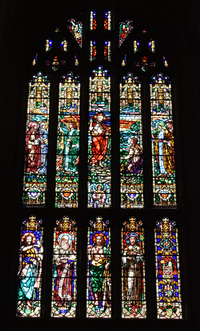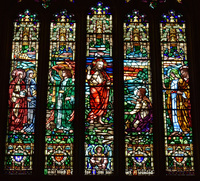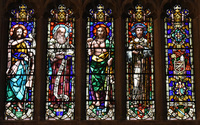Window
Building Name: Cathedral of the Most Blessed SacramentStudio Name: Willet Hauser Architectural Glass
City: Detroit
Window Shape: 6 (gothic arched, more than 2 vertical sections)
Subject/Title of Window: Christ Appears to the Holy Women
Brief Description of Subject: The canopy topping this 5 panel window is decorative in nature highlighted by angels with a censer.
The scene below is topped with decorative inscriptions from the Vulgate based on Matt. 28:4-5. The "Guide to the Cathedral of the Most Blessed Sacrament" gives an excellent description of this scene (see last paragraph). Just some comments. The early morning on Sunday is covered in all four Gospels and only differ in some details, especially in who came to the tomb. Only Matthew has exactly two woman -- Mary Magdalene and Mary the mother of James. To whom did Christ first appear after the Resurrection? Matthew has the two Mary's, Luke has two disciples on the road to Emmaus, both Mark and John, as in this window, have just Mary Magdalene. The meaning of the inscription from John 20:17 "Do not touch me for I am not yet ascended" has been a matter of debate for centuries. I am not sure what is represented in the last panel, possibly Luke's version -- the two disciples on the road to Emmaus. The angel is holding an Easter lily and in the background you can see the three crosses on Calvary. Below the scene are decorative coats-of-arms as befitting a Norman styled church as well as an angel holding a chalice.
In the lower portion of the window is depicted four saints with the artist's creation of their coat-of-arms as well as a decorative panel.
St. John the Baptist --- In Mark's Gospel, John, wearing a leathern girdle and clothes made out of camel's hair, preached the coming of Christ and baptized those that repented for their sins. He said that he baptized with water but the one that would come after him would baptize with the Holy Spirit. When he baptized Christ, he saw the Holy Spirit descend like a dove onto Christ.. That next day when he saw Jesus, he pointed to him and said "Ecce Agnus Dei" -- Behold the lamb of God (John 1:29). Attributes seen here include dressed in clothes made out of camel's hair, wearing what appears to be a leathern belt, holding a banner with the words "Ecce Agnus Dei" and pointing (to Jesus) with his right hand. I was not able to relate the coat-of-arms to John.
St. Anthony the Hermit aka St. Anthony Abbot. (231 - c.356) lived his entire life in Egypt and is known for being one of the early founders of the monastic way of life. After his parents died he sold all his possessions and, alone in the desert, devoted himself to work and prayer. He is famous for rejecting all the many temptations the devil through at him -- these became a popular subject for paintings. He is associated with the burial of St. Paul the Hermit. How he came to be associated with pigs and a bell has led to much speculation. One believable explanation is that later followers of St. Anthony were allowed to have there pigs run free for their food. They were identified as St. Anthony's pigs by wearing bells. Also how a book became an attribute is unknown as he did not read books as an adult. One explanation was that as a child he memorized prayers from books and later saw no need for books. I do not know specifically how he became connected with Venice. It must go back at least 400 years as there is a well known painting by Tintoretto, the subject of which is the Doge Da Ponte praying to St. Anthony the Hermit to get him to have the Virgin Mary intercede on their behalf to end the plague that was ravaging Venice in 1575. There is an inscription on a scroll that reads "Finis Coronat Opus" which means "the end crowns the work". Attributes seen here include a book, a pole cross (usually topped with a Tau cross but not here) with a bell, and in his coat-of-arms is an anchor cross and the logo of Venice (winged lion symbol of St. Mark with a paw on a book). I believe the inscription refers to his overcoming the devil's many temptations.
St. James the Less was an Apostle, first Bishop of Jerusalem and the writer of the Epistle of James. There is a legend that upon the death of Jesus he vowed that he would not eat again until he saw Jesus alive; the Resurrected Christ appeared to him and gave him bread. James the Less was martyred when he refused to deny Christ. He was thrown off a high wall, stoned and then killed with a fuller's club. Attributes seen here include a fuller's club, what I believe to be a piece of bread in his right hand and in the coat-of-arms is a castle tower -- possibly symbolizing a high wall.
St. Paul the Hermit (c.227 - c.345) is believed to be the first hermit. As a Christian he was forced to flee from the Decius persecutions and hid in a cave in the desert. The solitude agreed with him and he remained there the rest of his life. There is a legend that a raven would bring him a half a loaf a bread and one day when St. Anthony the Hermit visited him, the raven brought a whole loaf. Paul told Anthony that one day Anthony would be the one to bury him. After Anthony left he had a vision of Paul dressed in a white robe ascending to heaven. Attributes seen here include dressed in a white robe, a cross, a walking staff and in his coat-of-arms a raven carrying a loaf of bread. I was not able to identify the object near the top of the staff.
From the Guide to the Cathedral of the Most Blessed Sacrament, Copyright 1958, Archdiocese of Detroit. In the center panel, Mary Magdalene appears at the left hand of the Lord. In the other panels stand the holy women who had come with Mary to complete the anointing of the crucified Christ. The lower panels represent St. John the Baptist, St. Anthony the Hermit, St. James the Less, and St. Paul the Hermit.
Inscriptions: Do not touch Me for I am not yet Ascended
Christ Appears to the Holy Women
Christ Appears to the Holy Women, scene
Christ Appears to the Holy Women Saints
The MSGC is a constantly evolving database. Not all the data that has been collected by volunteers has been sorted and entered. Not every building has been completely documented.
All images in the Index are either born-digital photographs of windows or buildings or are scans of slides, prints, or other published sources. These images have been provided by volunteers and the quality of the material varies widely.
If you have any questions, additions or corrections, or think you can provide better images and are willing to share them, please contact donald20@msu.edu





